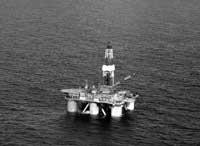Ancient technique to find new oil

However, oil companies can avoid these bad statistics. The key is in micropaleontology, that is, in the research of fossilized microorganisms. If this work is done correctly, experts often have more details about where to drill. This paleontological technique has been known since ancient times, but it was considered to be discarded for lack of value and now the problem is another: few experts know it. For this reason, Martin Langer, professor at the University of Bonn, has begun to train experts so that, with the proper interpretation of the signals emitted by micromissiles, they can locate oil deposits.
In search of black gold
Oil forms in the subsoil, in an area where the traces of marine microorganisms must withstand high pressures and temperatures, usually a few kilometers deep. Being the rocks more compact than oil, it filters towards the upper layers until it meets a waterproof layer that prevents it from going higher. The more waterproof the rock layer, the greater its oil retention capacity, resulting in a larger oil bag or oil tank.
To locate and extract the oil thus collected, the oil companies have the help of seismologists. Seismologists, using ultrasound-based tests, map local layers. Once experts in these layer maps have identified the points where oil accumulation conditions are collected, drilling work begins. However, as mentioned above, the chances of success are small, since the images obtained from the maps are limited and, in many cases, the perforations are made hundreds of meters from the appropriate location. For this reason, of the 10 perforations that are made, only one oil tank is found, and the size of one out of 100 is enough to perform profitable drilling. "Given the scarce success of the drilling currently underway, according to Martin Langer, and the price of each of them ranges between 2 and 25 million euros, the oil industry has realized that micropaleontology is a useful work tool. The use of this technique is cheap and effective. The economic side has revived this line of almost dead research."
Micropaleontology to find black gold



Micropaleontology XIX. It is a science founded in the nineteenth century and that is due to oil research efforts. In the last years of the 20th century, microfossils were investigated in oil search surveys.
When investigating microscopic fossils, oil research is much more accurate. The best fossils to find black gold are foraminifers, limestone microfossils in the form of currency. These fossils are the only human cells of marine antiquity, some smooth and other wrinkles, but always covered by a layer of limestone. Precisely the limestone layer is the main characteristic of these fossils that help find oil. Sediments with a high proportion of foraminifers, being porous, are able to absorb oil and gas as if they were sponges.
Using small fossils that emerge in perforations, experts can know if there is something in a particular place, if the drill has reached the warehouses or what is inside the hole. For their knowledge the morphology of microfossils is analyzed, since each geological epoch corresponds a type of microfossil with specific morphological characteristics. In these investigations, in addition to knowing the data on the age of rocks, experts can know the environmental characteristics of each era. Thus, the study of microfossils allows to know the temperature and depth of the water in which microorganisms were found, the amount of food in the past in the oceans, the productivity and degree of oxygenation of water, the characteristics of the climate, etc.
All this is important for those seeking oil. For oil and gas to form, certain conditions are needed. Knowledge of the environmental situation of each era allows predicting the location of oil deposits.
In the 1980s, when seismology began to be used, new oil search technology was thought to be sufficient. Consequently, the role of micropaleontologists who hitherto sought fossil fuels was discarded. Today, however, oil companies have realized the mistakes made then and know that the data obtained from the study of micromissiles may have more chances of finding oil than seismic maps.
The road to oil
The human being, aware of the existence of oil, has used it for a long time, according to historians thousands of years. However, the history of oil as a strategic issue for development is recent: In 1850 approximately 200 years it was first marketed by a Pittsburgh pharmacist under the name "oil" or "rock oil". It is then that the true history of oil begins, which becomes the engine of society.

For the extraction, production and exploitation of oil, the characteristics of each deposit are taken into account. To put a well into oil production, a cannon shaped tube is inserted into the deposit. The oil goes out through the holes to the well, from where it comes out by tubes of smaller diameter.
When due to underground pressure and the elements that accompany oil, water and gas, the deposit has its own energy, only oil comes out. In these cases a valve system is installed that will regulate the output of oil. If this pressure does not exist, other oil extraction systems are used. The best known is the balance, which thanks to the continuous movement causes the pump located inside the well to move. The absorbent pump extracts oil for the ground surface.
Oil generally does not come out clean, but mixed with sediments, water and natural gases. Once separated from these elements, oil is sent to the warehouses, from where it takes refineries through the oil pipelines. The natural gas that comes with oil is driven to the treatment plants for further treatment and subsequent shipment to the points of consumption through the gas deposits. Despite the advances in production processes, it is never possible to get all the oil out of the deposits, approximately half is inside.
In refineries oil, as if it were a food that comes to the kitchen, is "prepared", so it gets rough because it comes without cooking. In the refineries first the process of distillation with oil is carried out and then, as desired, different chemical processes can be carried out until all the elements have been extracted. Oil derivatives are extracted from refineries; diesel and similar fuels; polyethylene, benzene and other petrochemicals.
Petroleum derivatives and their use
- Normal and super diesel. They are mainly used in vehicles with internal combustion engine.

- Turbofuels. Diesel for jet aircraft.
- Aviation diesel. For use of aircraft with internal combustion engine.
- Diesel oil. Diesel used by trucks, buses and various cars.
- Kerosene. Also called oil, it is mainly used in industry and domestic heating.
- Propane gas. Industrial and residential fuel.
- Benzine . It is used as fuel for homes or for the production of certain types of solvents.
- Fuel oil. Fuel weight used in industrial furnaces and boilers.
- Aliphatic solvents. They are used for the extraction of paints, glues or oils, inks, rubber manufacturing, cleaning products, etc.
- Asphalt. Used to manufacture asphalt and sealing materials under construction.
- Bases lubricantes. They are raw materials for the production of lubricating oils.
- Paraffinic waxes. They are raw materials for the manufacture of candles, soil waxes, poxpoles, vaseline, etc.
- Polyethylene. One of the raw materials used in the plastic industry.
- Smell tar. Raw material for tire manufacturing.
- Naphthenic acid. Raw material for the manufacture of products used in the paint industry, resins, detergents, etc.
- Benzene. Cyclohexane raw material.
- Cyclohexane. It is used for different products used in the manufacture of nylon.
- Toluene. Solvent used in painting, ink, resin and adhesive processes.
- Mixed xylenes. They are used in the paint and insecticide industry.
- Alquibencenos. They are used in the cleaning and fur industry.
Other locations

In addition to micropaleontology, there are several oil search techniques, most of them related to geological studies.
One of the most common ways of obtaining images or photos by satellite, plane or radar. In this way, geological maps can be made and observe the characteristics of the places of interest: vegetation, topography, water currents, type of rock, geological faults... All this information allows to identify areas with characteristics that allow the presence of sediments in the subsoil.
In addition, magnetic and gravimetric systems installed on aircraft are used to obtain information about underground rocks. Geologists also personally analyze the chosen site and collect the stones from the ground for study. Experts collect information on the possibilities of finding hydrocarbons in the chosen area with all this data.
However, the most suitable systems are seismic. Small explosions occur in the subsoil and high sensitivity instruments are placed on the surface to collect the waves that cause the explosions. With this information, the instruments themselves develop an underground layer map. Geologists and geophysicists of oil companies analyze all the information and, if it is considered appropriate, prospecting is carried out.
Other uses of micropaleontology

Although the best known use of micropaleontology is the search for oil, this is not the only industrial application of this scientific field. It has also been used to look for submarine minerals, such as manganese, or water that may be in the subsoil at great depth.
In terms of science, research, being witnesses of the past, microfoils are the source of numerous data on life on earth and the history of climate, that is, the genesis, evolution and disappearance of species.
Microfosillas are also used in rarer things like forensic medicine or art. In fact, the microfossils that can be present in the paintings can say many things about the authenticity of the works and about the materials that the artist used. For example, original materials can also be used in renovation works.

It seems, therefore, that the future of micropaleontology is not bad. According to a recent report prepared by the United Nations, by 2050 the Earth will host 10 billion people. Obviously, the need for energy will also increase, so in addition to finding alternative sources of energy, there will be a need to bring performance to existing conventional energy sources. Currently fossil fuels oil, natural gas and coal are the main source of energy consumed. Logically, this generates many environmental problems that will force the countries of the world to bet, sooner or later, on the development of technology to obtain clean energy.
In the meantime, micropaleontology will have to continue to look for oil at the current speed, as existing fossil fuels will not last more than 40-60 years.
Published in D2 section of Deia.
Buletina
Bidali zure helbide elektronikoa eta jaso asteroko buletina zure sarrera-ontzian











